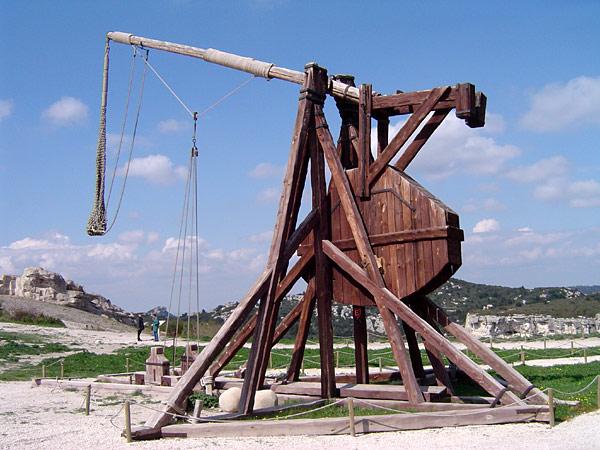
Boom! Energy Explorations -- Bounce on over to the library and join us for a great big bang with a catapulting contest!
Grades 1-5
Grades 1-5
(Based on: http://cheshirelibraryscience.wordpress.com/category/catapults/, http://cheshirelibraryscience.wordpress.com/category/energy/ including some of the explanations below -- Thanks for the ideas!)
As kids were arriving , played video of nature’s catapults: (a complete playlist for this program is here.
Read Book: Big Bang: The Tongue-Tickling Tale of a Speck that Became Spectacular – Carolyn Cinami DeCristofano (Alternatively, if wanted to emphasize the engineering aspect, could use: Rosie Revere, Engineer -- Andrea Beaty)

Discussion: “Big Bang” – a lot of energy – What is energy?
Asked kids: If you were asked to describe energy, what would you tell someone?
Energy is the ability or capacity to do work.
And what is work?
Work is done when something, regardless of size, moves.
In other words, energy is needed to cause motion.
Energy itself is generally divided into two categories: Kinetic and Potential.
Potential energy is stored energy that is waiting to work:
DEMO: Rubber Band --stretched a rubber band --this rubber band is holding potential energy -- Potential energy can be found in many forms – chemical, mechanical, nuclear, gravitational, and electrical. Gasoline, for example, is a chemical form of potential energy.
Let go of rubber band and watched it fly -- Kinetic energy is essentially the opposite of potential energy -- kinetic energy is energy in motion that is actually doing work. That rubber band flying is experiencing kinetic energy. So is a baseball being thrown or a person bicycling down the road. Where gasoline in a can is an example of potential energy, the fire that gasoline creates would be an example of kinetic energy.
Showed Youtube Song: Potential vs. Kinetic Energy
Anywhere you see motion there is energy. Even in classic cartoons!
Potential Energy: Wile E Coyote & Roadrunner
Demo: The Slinky! “Walked” slinky down a set of stairs made from boxes:
 The Slinky, which has been around since the 1940′s, provides an excellent example of potential and kinetic energy. When a slinky is sitting at the top of a set of stairs at rest, it is holding potential energy; as soon as it starts to “walk” down the stairs, it is experiencing kinetic energy.
The Slinky, which has been around since the 1940′s, provides an excellent example of potential and kinetic energy. When a slinky is sitting at the top of a set of stairs at rest, it is holding potential energy; as soon as it starts to “walk” down the stairs, it is experiencing kinetic energy. Slinky dropping down hanging mid-air: https://www.youtube.com/watch?v=oKb2tCtpvNU
Demo: the balancing egg. Half-fill a paper cup with water and set it on the table. Center a pie pan on top of the cup, with a TP tube standing in the pan. Balance an egg atop the tube. Strike the rim of the pie pan from the side, causing it to fly out and take the tube with it. The egg will hover in mid-air for a split second because of inertia. Gravity will then cause it to fall straight down into the water, unharmed.
“But what if you WANT to hurl something through the air?”
Different kinds of catapults - sling shots, trebuchets, and even aircraft catapults.
Mentioned opening video a sneaky grasshopper catapulted lots of bugs off of a leaf.
“the world’s largest slingshot,”: http://www.youtube.com/watch?v=lfJYGHOn3os
 Catapults used in medieval warfare: Making of Warwick Castle Trebuchet
Catapults used in medieval warfare: Making of Warwick Castle Trebuchet Giant trebuchet hurls a piano
Project time: Now we are going make catapults.
Catapults are another example of potential energy. When we pull the lever (or spoon) back, stretching the rubber band, potential energy in the spoon is transformed into kinetic energy when we release the spoon and let the pompoms fly!
(We used pom-poms instead of marshmallows out of food allergy concerns…the kids loved choosing their favorite colors and it made it easy to identify which catapult shot had the greatest distance.)
Children had the choice of making two different models:
 Simple catapult design (we recommended this for our 1st & 2nd graders)
Simple catapult design (we recommended this for our 1st & 2nd graders) Target Practice from PBS’s program FETCH (more complicated, so we suggested that 3rd-5th graders might want to try it.)
Target Practice from PBS’s program FETCH (more complicated, so we suggested that 3rd-5th graders might want to try it.) Then kids practiced launching pom-poms into a literature display rack we set up.
After the kids made and tested their models, they were encouraged to modify them. One father, watching the fun, created a great model of his own!
BWL 7/14
No comments:
Post a Comment